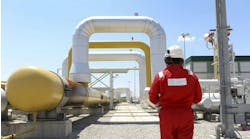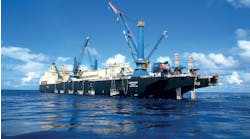Offshore staff
HUNTINGTON BEACH, Calif. – The subsea oil pipeline that leaked off the southern California coast was likely damaged by a ship’s anchor several months to a year before it ruptured, investigators said Friday.
As reported by the Associated Press, Coast Guard Capt. Jason Neubauer said that after the first strike it is possible other ships’ anchors subsequently struck the steel pipe. Investigators previously said a large section of the pipe was bowed after being struck and dragged along the seabed.
It remains unknown when the 13-in. crack in the pipe began leaking oil, and investigators will pour over a year of data on ship movements near the area of the break, the AP report said. “We’re going to be looking at every vessel movement over that pipeline, and every close encroachment from the anchorages for the entire course of the year,” Neubauer was quoted to say.
The accident scene is outside the Long Beach-Los Angeles port complex that is the largest in the country and handles some 4,000 vessels a year. Many of them are from overseas and that could complicate the process of boarding ships of interest in the investigation to get information.
The disclosure that the damage to the pipe could have occurred long ago dramatically reshaped what was known about the leak that reportedly sent tens of thousands of gallons of crude into the Pacific. A search that initially appeared to focus on the hunt for one vessel now could send investigators to ports around the country to inspect many ships.
According to the AP report, it now appears many factors played a role in the pipe’s failure – possible repeated anchor strikes; stresses from being dragged along the seafloor; and the corrosive forces of seawater.
Neubauer said investigators have narrowed their search to large cargo vessels that would be powerful enough to move a 4,000-ft section of pipeline 105 ft across the ocean floor. He also said investigators have zeroed in on a windy storm that occurred on Jan. 24-25; that storm could have caused problems for ships trying to anchor in the vicinity of the twin ports.
Investigators believe the initial anchor strike occurred sometime after a survey of the pipeline a year ago that showed the line was in its original location. The extended timeline was partly based on visible marine growth on the damaged length of the pipe that was revealed in an underwater survey.
The Coast Guard previously released video of the rupture spot and a wider view of the bowed pipe. A crack suggests that the pipe, which was installed in 1980, perhaps withstood an initial impact, but had been weakened over time by corrosion and became more prone to fail. Neubauer said that a debris field is visible on the seafloor near the break. Investigators will now remove that section of the pipe for lab analysis.
10/10/2021



